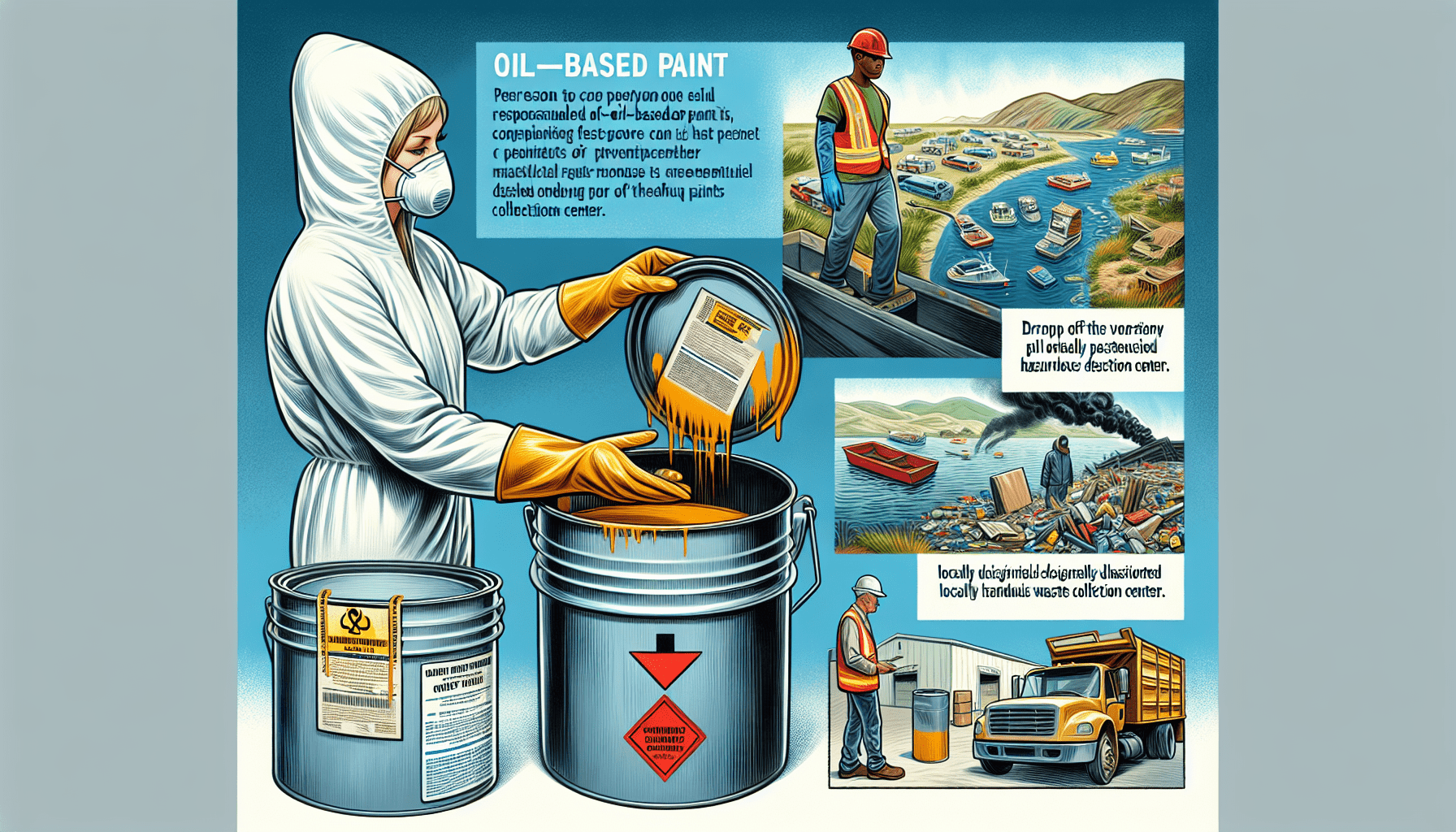You’re about to traverse the complex landscape of United States regulatory policies pertaining specifically to the use and sale of oil-based paints. This piece will carefully guide you through the list of states that have implemented restrictions or outright bans on oil-based paint due to concerns over environmental and health implications. Understanding these state-specific regulations can be instrumental in both your personal and business decisions relating to paint and home improvement projects. Prepare yourself to gain detailed insights into this intriguing aspect of American environmental legislation.
Overview of Oil-based Paint
In your quest to understand the discourse around paints, especially oil-based ones, it is essential to grasp what oil-based paint entails.
Definition of oil-based paint
Oil-based paint is a type of paint where the primary vehicle carrying the pigment is drying oil, or an oil that hardens upon exposure to air. An oil such as linseed oil is most commonly used in this type of paint, providing an attractive glossy finish when dried.
Advantages and disadvantages of oil-based paint
The appeal of oil-based paint rests largely in its durability and its rich, attractive finish. Given its high viscosity, it provides a smooth surface devoid of brush marks, imperfections, and provides excellent coverage over the previous color. It is also more water and stain-resistant compared to other types of paints.
However, it also comes with drawbacks. Oil-based paints have a longer drying time, can have a strong odor, and cleaning requires solvents rather than just water. The glossiness can also contribute to highlighting surface imperfections.
Health and environmental concerns
From an environmental and health perspective, oil-based paints traditionally contain high levels of volatile organic compounds (VOCs). VOCs contribute to ozone and smog formation and are linked to an array of health problems including headaches, loss of coordination, and in the long term, damage to the liver, kidney, and central nervous system.
State Bans on Oil-based Paint
As awareness around the environmental and health effects of VOCs has grown, so too have the actions to mitigate their impact.
Why states have banned oil-based paint
Several states have implemented bans or restrictions on oil-based paint to address the high VOC content. Reducing the use of these paints helps to lower the overall environmental impact and potential health risks associated with high VOC levels.
States that have banned oil-based paint
Among the states that have imposed outright bans or stiff regulations on oil-based paints are California, New York, Rhode Island, Minnesota, Massachusetts, Connecticut, Maine, New Hampshire, Vermont, and New Jersey.
Timeline of the bans
The timeline for these bans varies, with California being one of the first states to take action back in 1978. Most other states followed suit in the past decade as part of broader schemes to reduce VOC emissions.

States that Have Banned Oil-based Paint
Let’s delve into an examination of specific states and their respective bans.
California
In an aggressive move towards reducing pollution, California led the way with strict regulations on VOCs. The restrictions cover numerous products, including oil-based paint.
New York
New York imposed its ban on high-VOC oil-based paint in 2005, with the intent of protecting air quality and public health.
Rhode Island
Rhode Island recently passed legislation limiting the sale and use of high-VOC oil-based paints to protect environmental and public health.
Minnesota
In Minnesota, regulations were established that set VOC limits for architectural and industrial maintenance (AIM) coatings.
Massachusetts
Massachusetts implemented its ban driven by the goal of reducing air pollution and associated health risks.
Connecticut
Connecticut has placed restrictions on the manufacture, sale, and use of oil-based paint to decrease VOC emissions in the state.
Maine
In Maine, oil-based paints have been phased out as part of an initiative to reduce air pollution.
New Hampshire
New Hampshire’s Department of Environmental Services has been implemented rules that limit the VOC content in several consumer products, including oil-based paints.
Vermont
Vermont has enforced a ban on the sale of oil-based paints with high VOC levels as part of a statewide initiative to combat air pollution.
New Jersey
New Jersey has also taken steps to limit the VOC content in paints and coatings, hence limiting the use of oil-based paints.
California’s Ban on Oil-based Paint
California is well-known for its stringent regulatory environment, and this extends to oil-based paint.
Details of the ban
As per the California Air Resources Board (CARB), the state has set strict limits on the level of VOCs permissible in paint and coating products, effectively banning many types of oil-based paints.
Implementation and compliance
Strong regulatory oversight ensures companies’ compliance with this ban. Required reformulation often means that manufacturers decide it’s not profitable to sell these products in California.
Impact on industry and consumers
For the paint and coating industry, the ban has necessitated significant changes to their product lines. For consumers, they must adapt by using water-based paints or other alternatives.

New York’s Ban on Oil-based Paint
Similar to California, New York has a strict stance on oil-based paints.
Details of the ban
New York State’s Department of Environmental Conservation restricts the sale and usage of oil-based paints containing a VOC content over a certain limit.
Implementation and compliance
Regulatory mechanisms are in place to ensure adherence to the ban, with non-compliant companies facing steep penalties.
Impact on industry and consumers
For businesses, this ban has required product reformulations and rethinking marketing strategies. Consumers also have to adjust to new products and learn how to best apply them.
Rhode Island’s Ban on Oil-based Paint
Rhode Island’s ban, although fairly recent, has been quite effective.
Details of the ban
Rhode Island’s Department of Environmental Management has set a particular VOC limit for architectural coatings.
Implementation and compliance
Enforcement of this rule is strict and is overseen by the relevant authorities.
Impact on industry and consumers
Again, this ban has major implications for manufacturers, retailers, and consumers alike. Manufacturers have had to adjust their product lines, while consumers have had to find alternatives to oil-based paints.
Minnesota’s Ban on Oil-based Paint
Minnesota’s restrictions are also aimed at decreasing harmful emissions.
Details of the ban
Under the Minnesota Pollution Control Agency’s rules, oil-based paints exceeding a certain VOC limit cannot be sold or used within the state.
Implementation and compliance
The state has mechanisms in place to ensure manufacturers, retailers, and consumers adhere to the regulation.
Impact on industry and consumers
This ban has spurred manufacturers to develop new, lower VOC paints. For consumers, there has been a learning curve in using alternatives to oil-based paints.
Massachusetts’ Ban on Oil-based Paint
Massachusetts has adopted a similar approach to other states.
Details of the ban
High VOC oil-based paints cannot be sold, manufactured, or even used in the state according to Massachusetts’ Department of Environmental Protection.
Implementation and compliance
The ban is enforced rigorously to ensure compliance from manufacturers and consumers.
Impact on industry and consumers
The paint industry in Massachusetts, like in other states, has had to innovate and develop new products in response to this ban, while consumers have had to adapt their practices accordingly.
Connecticut’s Ban on Oil-based Paint
In Connecticut, measures have also been taken to cut down on the use of high-VOC oil-based paint.
Details of the ban
Under Connecticut’s Department of Energy and Environmental Protection rules, the VOC content in paint and coating products is highly limited.
Implementation and compliance
The state’s regulations are stringently enforced, ensuring that manufacturers and retailers adhere to the ban.
Impact on industry and consumers
Manufacturers, retailers, and consumers all face an adjustment period following the implementation of this ban, but the overall goal of reducing VOC emissions has made these changes necessary and beneficial in the long run.
New Jersey’s Ban on Oil-based Paint
New Jersey is part of the states spearheading bans on oil-based paints.
Details of the ban
Under New Jersey’s Department of Environmental Protection, the VOC content allowed in certain paints and coatings is extremely reduced.
Implementation and compliance
The state ensures compliance with this ban through strict enforcement and penalties for violations.
Impact on industry and consumers
Manufacturers have had to revise their offerings while consumers have had to learn how to apply new product types effectively. Despite these adjustments, the ban ultimately serves to fulfill the state’s commitment to air quality and public health.



